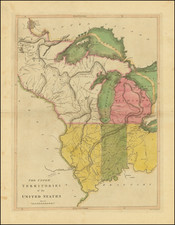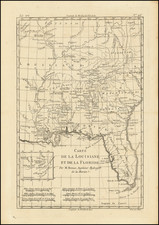Rare bidseye view of Defiance, Ohio, privately printed for the St. John's Church, in connection with fund raising efforts.
The view is almost certainly the earliest extant large format birdseye view of Defiance, coming only a decade after the town begam to grow from a small village to a regional economic hub. The view captures the image of a thriving community, with river commerce, smoke stacks and the local Wabash & Erie Canal lock are prominently displayed.
We have dated the view to circa 1856, as John Ruhl served as pastor of the St. Johns Church from 1856 to 1858, at which time he returned to the practice of Medicine. As noted in the The history of the Pittsburgh Synod of the Reformed Church . . .
John Ruhl was born in Iba, in Hesse, Germany, May 4th, 1821, and came to America in 1836. He studied privately under Rev. Isaac Shellhammer in Luzerne County, Pa., and Rev. John W. Hamm, in Ohio. He was licensed in 1845 by Sandusky Classis and appointed missionary at various points in Medina and Summit Counties, Ohio. From 1847 to 1860 he served pastorates at Congress, Meron, Defiance and Bazil, Ohio. Then his voice failed and he studied medicine and practiced until 1869, when he came to Frostburg, Md., and was pastor there for sixteen years, and built up a flourishing congregation. He died in Frostburg, May 29th, 1885
Defiance is the county seat of Defiance County, Ohio. The city was named for Fort Defiance, which built on the site of the present city. In August 1794, General "Mad Anthony" Wayne ordered the construction of Fort Defiance at the confluence of the Auglaize and Maumee Rivers. Wayne built the fort during his campaign against the Indians of Ohio to provide his men with protection and a staging ground for their operations. The fort was a rough square with a blockhouse located on each corner. In addition to the stockade, a wall of earth eight feet thick and a ditch eight feet deep and fifteen feet wide protected the fortifications. Lieutenant John Boyer, an officer in Wayne's army, claimed that the fort could protect the American soldiers from "the English, the Indians, and all the devils in hell."
Following the Battle of Fallen Timbers, Wayne utilized Fort Defiance as his base of operations. He ordered the destruction of all Indian villages and crops within a fifty mile radius of the fort. When Native Americans and the United States signed the Treaty of Greeneville in 1795, the natives permitted the Americans to maintain a trading post and fort at Fort Defiance, although the whites had ceded the right to settle this portion of Ohio. Until the War of 1812, Fort Defiance served as one of the western-most outposts in Ohio, guarding citizens from native attacks. William Henry Harrison utilized the fort in his attacks against Indians in the early 1810s as well as a staging area for attacks against the British in the War of 1812. Modern-day Defiance, Ohio, was founded at the fort's location in 1822. Local Indian tribes had signed away their rights to the surrounding land in 1817.
Defiance grew slowly, having approximately seven hundred residents in 1846. That same year, the town consisted of two churches and five retail stores. Over the next thirty-four years, Defiance's population increased dramatically to 5,907 residents in 1880.












![Carte De La Louisiane Et Du Cours Du Mississipi . . . Juin 1718 [1st State!]](https://storage.googleapis.com/raremaps/img/small/59797.jpg)
![Carte Qui Contient La Maniere Dont Se Fait La Chasse Des Bouefs Sauvages . . . [Buffalo, Niagara Falls, Calumet Village, Huron & Illinois Indians]](https://storage.googleapis.com/raremaps/img/small/93146.jpg)
![[Hand Drawn Map] Le Golfe de Mexique avec les Pays Circonvoisins](https://storage.googleapis.com/raremaps/img/small/91580.jpg)